Ideas coming into place
An Introduction to “Basho” in the Works of Kitarō Nishida
DOI:
https://doi.org/10.13135/2036-542X/8886Keywords:
Kitarō Nishida, basho, khôra, tópos, SpaceAbstract
According to James Heisig, Japanese philosopher Kitarō Nishida’s (1870 – 1945) conception of place [場所 – basho] acted as a “magnet” that drove together all of the philosopher’s previous acceptations. In fact, there is no exaggeration in saying that, from the time of its inception in Expressive action [表現作用 – Hyōgen Sayō] from 1925, it seemed that “basho” was the idea that Nishida had been looking for throughout his entire career as a philosopher. The long path the “conceptions of space” and the idea of “place” took from the Platonic “khôra” and the Aristotelian “tópos” finally come to fruition in Nishida’s philosophy as “basho” which represents, in short, the place in which universals are expressed (or projected) as phenomena for the observing self.
This article presents itself as an analysis of the inception of Nishida’s conception of “basho” in many of his works dated from the 1920’s, as well as an examination of the semantics of the Chinese characters “場” and “所” that, together, constitute the Japanese word “basho” [場所], as a means to understand what kind of specific characteristics lie in the root of the distinction between it and the Western terms often used to describe “space” and “place.”


